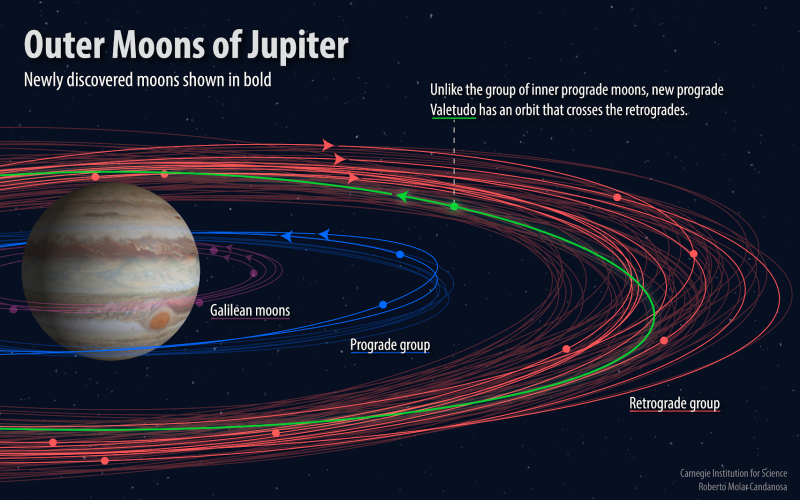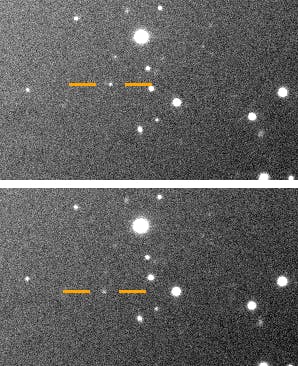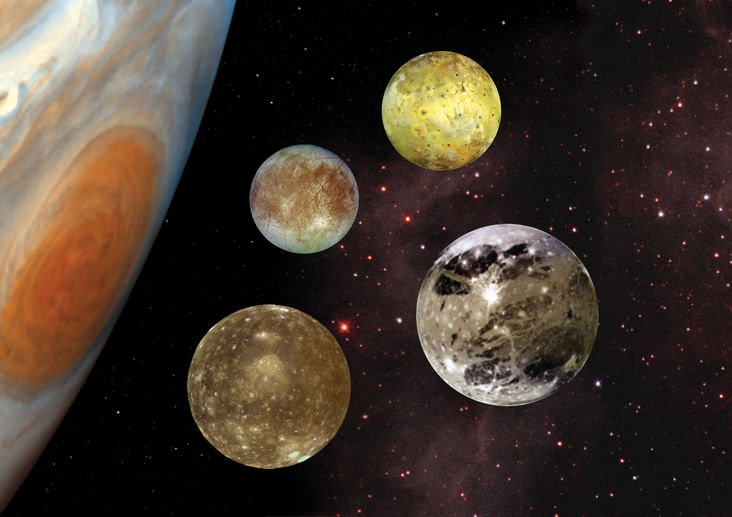
Our solar system is full of moons of many different kinds, just as diverse and amazing as the planets they orbit. While Earth only has one moon, and some planets, like Mercury and Venus, have none, others have dozens, namely Jupiter and Saturn. The ice giants Uranus and Neptune also have quite a few each. On July 17, 2018, astronomers announced they’ve discovered even more moons orbiting Jupiter – 10 additional moons, in fact, bringing the known total of Jupiter’s moons now to 79. Nine of those 10 moons are what the astronomers are calling normal, but they’ve labeled one as a real oddball. As so often happens, the astronomers found the moons while searching for something completely unrelated.
These astronomers said they came upon the new moons while searching the outer solar system for evidence of Planet Nine, a large, as-yet unseen planet thought by some scientists to exist in the far outer reaches of the solar system, far beyond Pluto. That was in the spring of 2017. Scott S. Sheppard of the Carnegie Institute for Science led the astronomy team. He said Jupiter happened to be near the search field where they were searching for Planet Nine, and he added:
Jupiter just happened to be in the sky near the search fields where we were looking for extremely distant solar system objects, so we were serendipitously able to look for new moons around Jupiter while at the same time looking for planets at the fringes of our solar system.

Why are we just now hearing about it? These astronomers said that, while the new observations were exciting, they needed to confirmed them. As Gareth Williams at the International Astronomical Union’s Minor Planet Center explained:
It takes several observations to confirm an object actually orbits around Jupiter. So, the whole process took a year.
It should be noted that the July 17 announcement by Carnegie Science also contains two moons that had been previously found and announced in 2017. Those 2017 moons were labeled S/2016 J1 and S/2017 J1. That gives us a total of 12 new moons for Jupiter confirmed since early 2017, two last year and 10 this year.
All of these new moons are very small, only about one to three kilometers across (a kilometer is 0.6 miles). In that way, they’re like many of Jupiter’s other small moons. They’re thought to have formed after the gas and dust from the earliest stages of planetary formation had dissipated.
Nine of the 10 new moons orbit in a retrograde direction, that is, opposite direction of Jupiter’s spin. They are part of a larger swarm of moons orbiting a long distance out from Jupiter. All of these moons are thought to be the remnants of three much larger bodies that were destroyed by collisions with other moons, asteroids or comets.
The 10th new moon is the oddball. It’s more distant than Jupiter’s prograde moons – those that orbit in the same direction as Jupiter’s spin – and its orbit is much more inclined, crossing the orbits of the outer retrograde moons. It has been nicknamed Valetudo, after the Roman god Jupiter’s great-granddaughter. According to Sheppard:
Our other discovery is a real oddball and has an orbit like no other known Jovian moon. It’s also likely Jupiter’s smallest known moon, being less than one kilometer (0.6 miles) in diameter.
Since Valetudo is moving in the opposite direction to the other retrograde moons, there is a greater chance of a collision occurring, and is probably inevitable. As Sheppard noted:
This is an unstable situation. Head-on collisions would quickly break apart and grind the objects down to dust.
At Inverse.com, Sheppard also offered an earthbound analogy, saying that:
It’s actually going head-on into these retrograde objects. It would be like driving down a highway going the wrong way.
Such collisions would have been very common earlier in Jupiter’s history, when most of the moons were still forming from the gas and dust surrounding the young planet.

The two other moons mentioned by Carnegie Science are much closer to Jupiter, and orbit in the prograde direction, the same direction as Jupiter’s rotation. They are also part of a larger group of small moons thought to be the left-over remnants of a once larger moon.
So we are still finding moons for Jupiter. As for how many ultimately will be found, no one knows for sure. For a long time the number hovered at 69, and now it is 79. It’s likely that even more small moons are still waiting to be found. According to Sheppard:
Well, it probably won’t stay at 79 for very long. We actually found, on some of the best nights we had, we could image objects even deeper – things that are right on the edge of our noise. There’s many more smaller moons around Jupiter. It’s just very hard to follow those.
Bottom line: For a long time, Jupiter had been known to have dozens of moons. Now, thanks to a search that was primarily for Planet Nine, astronomers have discovered even more – for a total of 79. This is the largest number of moons of any planet in the solar system.
Via Carnegie Institute for Science
Enjoying EarthSky so far? Sign up for our free daily newsletter today!











